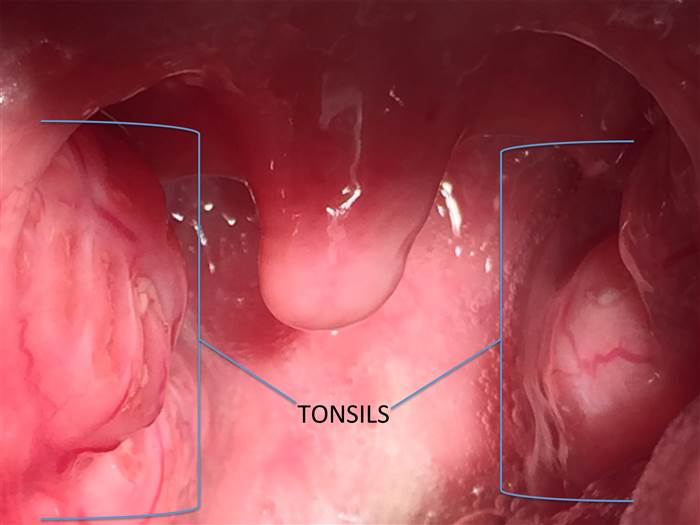TONSILS; the silent Army
Looking in the mirror admiring the arrangements of teeth and the importance of tongue as an organ of speech. There lies small masses of flesh called tonsils found in pairs at the back of the throat of many mammals which also includes humans. The tonsils are small gland like structures that are located on the lateral parts of the throat.

Image credit
Have you ever wondered what it use might be to the body or what role it do play in the position it is?? Because most times it looks like it doesnt have a use. But in reality every single part of the human body has a role(s) it do play or contribute to the general well being of the human system
Types of Tonsils with its location
In humans the word tonsils is used to describe three sets of this spongy lymphatic tissue which are;
- the lingual tonsils
- the pharyngeal tonsils
- Palatine tonsils

[Image shot from my school science laboratory]
The palatine tonsils are the oval bit that hang down from either at the back of your throat, you can see them if you open your mouth wide in the mirror. Primarily the palatine produces antibodies and because of their renowned position in the throat, they are believed to be the first line of defense against potential infection in both respiratory and digestive tracts
The pharyngeal tonsils are also known as adeniods. These are found tucked away in the nasal pharynx and serve a similar purpose to the palatine tonsils but they do shrink in adulthood
The lingual tonsil are found at the back of the tongue towards it roots where it attaches and if you poke your tongue right out with caution i mean, you will be able to spot them if you look in the mirror. These are drained very effiently by mucous gland and as a result, they very rarely get infected
Tonsillitis in Focus
Tonsillitis is usually caused by certain bacteria(e.g group A beta-haemolytic streptococci) and sometimes viral infections that result in a sore and wounded throat, a fever, white spots at the back of the throat and difficulty swallowing.
Usually rest and antibiotics will see them off, but occasionally the infection is more severe and can cause severe problems or reoccurs frequently. In this cases a tonsillectomy may be adviced - a surgical procedure to remove tonsils.
The adenoids are less commonly affected, but when they are, can become inflamed and swell to obstruct breathing through nose and drainage from the sinuses, which can lead to further infections.
In young people contanst breathing through the mouth can stress the facial bones and cause deformities, so children will sometimes have their adenoids removed
Children come into close contact with others at school and play, exposing them to a variety of viruses and bacteria. This makes them particularly vulnerable to the germs that cause tonsillitis.
Symptoms of Tonsillitis
Tonsillitis do not just come all in one day, there are always some yellow light or warnings you might say that shows the likelihood of its presence in ones body. Such warnings are known as symptoms and they include;
Breathing through the nose may be noisy or rattly. This may become worse and cause difficulty breathing through the nose. The child then mainly mouth breathes.
Swollen adenoids may block the entrance of the Eustachian tube. This is the tube that goes from the back of the nose to the middle ear. It normally allows air to get into the middle ear.
Snoring at night. In severe cases sleep may be disrupted by the blocked nose and there is difficulty with breathing.
a very sore throat
difficulty swallowing or painful swallowing
a scratchy sounding voice
bad breath
fever
chills (a cold feeling)
jaw and neck tenderness due to swollen lymph nodes
tonsils that appear red and swollen
tonsils that have white and yellow spots
Treatment for tonsillitis

[Image shot from my school science laboratory]
A mild case of tonsillitis may not necessarily require treatment, especially if a virus, such as a cold , causes it.
Treatments for more severe cases of tonsillitis may include antibiotics or a tonsillectomy .
Antibiotics will be prescribed by your doctor to fight a bacterial infection. It’s important you complete the full course of antibiotics. Your doctor may want you to schedule a follow-up visit to ensure that the medication was effective.
Surgery to remove the tonsils is called a tonsillectomy. This was once a very common procedure. However, tonsillectomies today are only recommended for people who experience chronic or recurrent tonsillitis. Surgery is also recommend to treat tonsillitis that doesn’t respond to other treatment, or tonsillitis that causes complications.
If a person becomes dehydrated due to tonsillitis, they may need intravenous fluids using the veins. Pain medicines to relieve the sore throat can also help while the throat is healing.
BASIC TIPS TO EASE SORE THROAT
- Drink plenty of fluids
- Get lots of rest
- Gargle with warm salt water several times a day
- Use throat lozenges
- Use a humidifier to moisten the air in your home
- Avoid smoke
Activity
Perform a 1-3 minutes mouth gargling using a warm salt water at least once a day